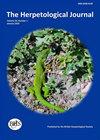Bayesian insights into Green Pit Viper Trimeresurus (Cryptelytrops) macrops sexual dimorphism with respect to influence of gravidity and habitat disturbance
IF 1.1
4区 生物学
Q3 ZOOLOGY
引用次数: 0
Abstract
Sexual dimorphism is expressed in many taxa as a form of resource partitioning and as a response to unique challenges faced by male and female organisms. We investigated this phenomenon for an arboreal green pit viper species, Trimeresurus macrops, previously suggested to display obvious sexual dimorphism. We evaluated seven external characters and scaled mass index (SMI) of 73 vipers (N = 32 males, N = 41 females) obtained during night surveys and opportunistic searches in north-east Thailand from January 2015–January 2017. We utilised Bayesian inference to investigate the influence of sex, gravidity, and rural habitat disturbance on sexual dimorphism of T. macrops, and we provide 95 % highest density intervals (HDI) for the difference in means (posterior distribution). We also present ecologically relevant probabilities of observing dimorphism for each external character and SMI by sex, gravidity (gravid or not), and habitat type (rural or forest). Females were larger than males in both forested and rural habitat, females in rural habitat were larger than forest females, and all males displayed a conspicuous white eye-stripe. When gravid females were excluded from analyses, probability of observing dimorphism drastically decreased. Knowledge of niche partitioning and the specific challenges encountered by males and females, gravid and non-gravid females, and individuals persisting in rural habitats will prove valuable for conservation and snakebite mitigation of T. macrops. Keywords: Difference of body size, south-east Asia, Bayesian inference, arboreal viper ความแตกต่างระหว่างเพศ (sexual dimorphism) ถูกปรากฎในอนุกรมวิธานสัตว์ว่าเป็นรูปแบบหนึ่งของการแบ่งปันทรัพยากร (resource partitioning) และการท้าทายจำเพาะจากสิ่งมีชีวิตเพศผู้และเพศเมีย เราศึกษาปรากฏการณ์นี้ในกลุ่มงูเขียวหางไห้ที่มีถิ่นอาศัยอยู่บนต้นไม้ ชนิดพันธุ์ งูเขียวหางไหม้ตาโต Trimeresurus macrops ซึ่งได้รับการเสนอในการศึกษาก่อนหน้าว่ามีการแสดงออกของความแตกต่างระหว่างเพศอย่างชัดเจน นักวิจัยทำการประเมินลักษณะภายนอกทั้ง 7 ลักษณะและScaled mass index (SMI) ของงูเขียวหางไหม้จำนวน 73 ตัว (ตัวผู้ 32 ตัว, ตัวเมีย 41 ตัว) จากการสำรวจตอนกลางคืนและการสำรวจตามโอกาสในพื้นที่ภาคตะวันออกเฉียงเหนือของประเทศไทยตั้งแต่เดือนมกราคม พ.ศ. 2558 - มกราคม พ.ศ. 2560 เราใช้การอนุมานแบบเบย์เพื่อตรวจสอบอิทธิพลของเพศ การตั้งครรภ์ และการรบกวนถิ่นอาศัยในพื้นที่เกษตรกรรมต่อความแตกต่างระหว่างเพศของงูเขียวหางไหม้ตาโต T. macrops และเราให้ช่วง HDI อยู่ที่ 95% สำหรับความแตกต่างของค่าเฉลี่ย (การแจกแจงหลัง) นอกจากนี้ เรานำเสนอความน่าจะเป็นที่เกี่ยวข้องกับระบบนิเวศในการสังเกตความแตกต่างของลักษณะภายนอกและ SMI ตามเพศ การตั้งครรภ์ (มีหรือไม่มี) และประเภทที่อยู่อาศัย (พื้นที่เกษตรกรรมหรือป่า) การศึกษาพบว่า งูเขียวหางไหม้ตัวเมียมีขนาดใหญ่กว่าตัวผู้ทั้งที่อาศัยในป่าและพื้นที่เกษตรกรรม โดยงูเขียวหางไหม้ตัวเมียในที่อยู่อาศัยพื้นที่เกษตรกรรมจะมีขนาดใหญ่กว่าที่พบในป่า และตัวผู้ทุกตัวมีแถบตาสีขาวที่สังเกตเห็นชัดเจน ทั้งนี้เมื่องูเขียวหางไหม้เพศเมียที่ตั้งครรภ์ถูกแยกออกจากการวิเคราะห์ ค่าความน่าจะเป็นในการสังเกตความแตกต่างระหว่างเพศถูกลดทอนลงเป็นอย่างมาก โดยความรู้เกี่ยวกับการแบ่งกลุ่มเฉพาะและความท้าทายจำเพาะที่พบโดยงูเขียวหางไหม้เพศผู้และเพศเมีย งูเพศเมียที่มีการตั้งครรภ์ และตัวอย่างอื่น ๆ ที่อาศัยอยู่ในเกษตรกรรมจะพิสูจน์ได้ว่ามีคุณค่าสำหรับการอนุรักษ์และการลดปัญหาการถูกงูกัดของงูเขียวหางไหม้ตาโต T. macrops สืบไป绿坑蝰蛇(Cryptelytrops)两性二态性在重力和生境干扰方面的贝叶斯洞见
两性二态性在许多分类群中表现为资源分配的一种形式,也是对雄性和雌性生物面临的独特挑战的一种反应。我们对一种树栖绿坑蝰(Trimeresurus macrops)进行了这一现象的研究,该物种以前被认为表现出明显的性别二态性。我们评估了2015年1月至2017年1月在泰国东北部通过夜间调查和机会性搜索获得的73条毒蛇(雄性32条,雌性41条)的7个外部特征和比例质量指数(SMI)。利用贝叶斯推理方法研究了性别、重力和农村生境干扰对大腹大鼠两性二态性的影响,并为均值差异(后验分布)提供了95%的最高密度区间(HDI)。我们还根据性别、重力(是否重力)和栖息地类型(农村或森林)提出了观察到每种外部性状和SMI二态性的生态学相关概率。森林生境和乡村生境雌虫均大于雄虫,乡村生境雌虫大于森林生境雌虫,雄虫均有明显的白色眼纹。当怀孕的雌性被排除在分析之外时,观察到二态性的可能性大大降低。了解生态位划分以及雄性和雌性、怀孕和未怀孕的雌性以及在农村栖息地持续生存的个体所面临的具体挑战,将证明对保护和减轻大腹蛇咬伤有价值。关键词:体型差异,东南亚,贝叶斯推断,树栖毒蛇ความแตกต่างระหว่างเพศ(两性异形)ถูกปรากฎในอนุกรมวิธานสัตว์ว่าเป็นรูปแบบหนึ่งของการแบ่งปันทรัพยากร(资源分区)และการท้าทายจำเพาะจากสิ่งมีชีวิตเพศผู้และเพศเมียเราศึกษาปรากฏการณ์นี้ในกลุ่มงูเขียวหางไห้ที่มีถิ่นอาศัยอยู่บนต้นไม้ชนิดพันธุ์งูเขียวหางไหม้ตาโตTrimeresurus macropsซึ่งได้รับการเสนอในการศึกษาก่อนหน้าว่ามีการแสดงออกของความแตกต่างระหว่างเพศอย่างชัดเจนนักวิจัยทำการประเมินลักษณะภายนอกทั้ง7ลักษณะและ缩放质量指数(SMI)ของงูเขียวหางไหม้จำนวน73ตัว(ตัวผู้32ตัว,ตัวเมีย41ตัว)จากการสำรวจตอนกลางคืนและการสำรวจตามโอกาสในพื้นที่ภาคตะวันออกเฉียงเหนือของประเทศไทยตั้งแต่เดือนมกราคมพศ。2558 -。2560年เราใช้การอนุมานแบบเบย์เพื่อตรวจสอบอิทธิพลของเพศการตั้งครรภ์และการรบกวนถิ่นอาศัยในพื้นที่เกษตรกรรมต่อความแตกต่างระหว่างเพศของงูเขียวหางไหม้ตาโตt macropsและเราให้ช่วงHDIอยู่ที่95%สำหรับความแตกต่างของค่าเฉลี่ย(การแจกแจงหลัง)นอกจากนี้เรานำเสนอความน่าจะเป็นที่เกี่ยวข้องกับระบบนิเวศในการสังเกตความแตกต่างของลักษณะภายนอกและ重度ตามเพศการตั้งครรภ์(มีหรือไม่มี)และประเภทที่อยู่อาศัย(พื้นที่เกษตรกรรมหรือป่า)การศึกษาพบว่างูเขียวหางไหม้ตัวเมียมีขนาดใหญ่กว่าตัวผู้ทั้งที่อาศัยในป่าและพื้นที่เกษตรกรรมโดยงูเขียวหางไหม้ตัวเมียในที่อยู่อาศัยพื้นที่เกษตรกรรมจะมีขนาดใหญ่กว่าที่พบในป่าและตัวผู้ทุกตัวมีแถบตาสีขาวที่สังเกตเห็นชัดเจนทั้งนี้เมื่องูเขียวหางไหม้เพศเมียที่ตั้งครรภ์ถูกแยกออกจากการวิเคราะห์ค่าความน่าจะเป็นในการสังเกตความแตกต่างระหว่างเพศถูกลดทอนลงเป็นอย่างมากโดยความรู้เกี่ยวกับการแบ่งกลุ่มเฉพาะและความท้าทายจำเพาะที่พบโดยงูเขียวหางไหม้เพศผู้และเพศเมียงูเพศเมียที่มีการตั้งครรภ์และตัวอย่างอื่นๆที่อาศัยอยู่ในเกษตรกรรมจะพิสูจน์ได้ว่ามีคุณค่าสำหรับการอนุรักษ์และการลดปัญหาการถูกงูกัดของงูเขียวหางไหม้ตาโตt macropsสืบไป
本文章由计算机程序翻译,如有差异,请以英文原文为准。
求助全文
约1分钟内获得全文
求助全文
来源期刊

Herpetological Journal
生物-动物学
CiteScore
2.40
自引率
10.00%
发文量
25
审稿时长
>12 weeks
期刊介绍:
The Herpetological Journal is the Society''s prestigious quarterly scientific journal.
 求助内容:
求助内容: 应助结果提醒方式:
应助结果提醒方式:


